THE RAJAM ART COLLECTION

Those CyberCadets who visit TAKA or read our books well know the amazing artwork of S. Rajam (10 February 1919 29 January 2010) musician and painter from Tamil Nadu. He worked on our art commissions for decades and by a small miracle we acquired his life's work, some 60 years worth, which we brought to Kauai and have kept in an archive container.
Amy-Ruth Holt, PhD in Art History (Ohio State University), came to know of the collection and flew to Kauai with her daughter, Maya, to spend five days cataloging and photographing key parts of the collection.
They have been sorting through the hundreds of paintings, all roughly organized in large manila envelopes, bringing new clarity to our collection. We thank you both for this important (and tedious) work, something only an expert could accomplish.
And we honor S. Rajam. His work lives on in every corner of our mission.
Bronze Panels for Iraivan
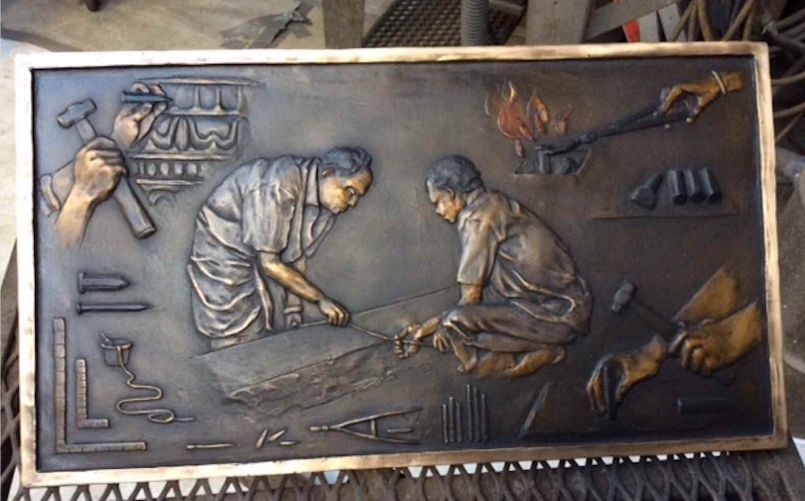
After years of writing text that would last a thousand years (no pressure, right?) and sculpting and casting, nine of the 35 panels are being shipped today from Loveland, Colorado, to be installed on the perimeter wall.
The shipper sent some (not so great) photos. The actual panels are works of art. As CyberCadets know, they give the history, philosophy and beliefs of monistic Saiva Siddhanta. Pilgrims of the future will use them like a bronze illustrated library to understand the temple, how and by whom it was built, and of course lots about its founder, Gurudeva. Stay tuned for the installation in the weeks ahead.
Finding God in a Cave

This is a story taken from The Guru Chronicles, the official history of our lineage. It is of Gurudeva's days in Sri Lanka prior to his meeting Yogaswami. It is a long story, but worthy of a read when you find a quiet 20 minutes, a story full of holy men and ideas.
Robert Hansen's search for his guru took him across the seas on a merchant vessel to India and by train to South India where he caught a ferry to Ceylon, arriving in Colombo in March of 1947. As arranged by Grace Burroughs, he studied with Dayananda Priyadasi, a Sinhalese Buddhist teacher of meditation and occultism who had visited the US in the mid-1930s and captivated seekers there.
"One day my training was completed. My teacher, Dayananda, few off to attend a religious conference in Switzerland. I was alone in Ceylon. I thought about the cave again. One of my close Muslim friends, Anbakara, who had Hanuman as his mentor, took me to the caves of Jailani, Kuragala, Balangoda, secluded caves naturally carved in solid rock in a mountainous valley deep in the central jungles of the island. There I met my fifth catalyst on the path of enlightenment. His name was Mustan."
The Jailani Caves are 150 kilometers southeast of Colombo, in the remote jungles. It is to this day a holy site, and a gathering place for Su mystics. The journey of several days wended through the nearly uninhabited central hills of Ceylon, with its tiny villages and dusty roads. Robert saw elephants bathing in the rivers and pulling logs on massive chains out of the forests. It must have seemed a wonderland to the American, a Shangri-La. One thing was for certain, it was far from the life he had been so actively immersed in. It was the refuge he had longed for.
Up the hill Robert and Anbakara walked to the mouth of the rock caves overlooking the Kaltota Plains. What they encountered is described by R.H. Bassett in Romantic Ceylon, Its History, Legend and Story, published in 1929:
"The cave itself is a most interesting place. It is entirely natural, bearing no signs of artificial excavations or of ritual adornment. The entrance is situated in the face of a cliff a short climb down from the summit where on entering there is a large "hall" from which two passages lead off on either hand. The right hand passage is seen to extend for at least 50 yards into the depths of the Earth before merging into the general darkness of the shadows.
On the opposite side of the entrance hall, a narrow passage leads out on to the meditation "ledge," a niche in the sheer side of the cliff, some 6 foot by 4 foot with an overhanging roof of rock. Here seated beneath a huge mass that towers fifty feet above on the edge of a 600-foot precipice, a hermit can find solitude indeed and food for contemplation in the unbroken ocean of trees spread out below him. Entering from a small hole in the rock, at the back an atmosphere of complete detachment pervades the occupant of the tiny ledge. Earthly considerations lose their importance before the uncomplicated immensity of the colossal landscape and the fatality of the sheer abyss."
Robert was home. He was here to meditate until he realized the Self. But his mind wandered to his lifelong ambitions for improving conditions in the world by the power of spirit. World War II had just ended, and he had the highest of hopes of a peaceful new age for humanity, as expressed in a letter dated December 28, 1948:
"Remember the day when evil forces held sway and how we did pray to pen the way for Freedom of Nations through World Federation by building this Nation in a cooperative way? Evil forces are gone, we continue, March on and lead all these Nations into the net of Universal Love for the masses irrespective of classes, and release all from bondage, strife into new Life."
Another mystic was living at Jailani, a wonderful Muslim called Mustan. Decades later, in relating the story to his monastics, Gurudeva recounted:
"They say Mustan never took a bath, but he smelled as sweet as a flower. He was so old; he was so pure. We had a wonderful meeting. When he saw me he said, "I had a dream about you." Then Mustan pulled a little notebook out of his pocket. He said, "I wrote it down here where I write down all of my dreams." I said to him, through my friend who translated from Arabic into English, "I had a dream about you, too," which I had just a few nights before. I had written it down also. I had been trained at that time to write down all my dreams. He said, "My dream was during the last full moon." We compared dates. We had both written down the same dream at the same time about our meeting together on the inner planes at night while we slept.
He began giving to me a profound training centered on the conscious use of the third eye. He explained and projected with his mind force the intricate capabilities, development and unfoldment of the faculties of this chakra. Mustan lived in a small cave with a little door on it. One had to walk many steps up the side of a hill to get to it. I lived in a nearby mosque at the foot of the path to his cave.
At night he took me out and meditated with me on wind-swept hills where yogis used to meditate hundreds of years ago. He made me sit perfectly straight for hours at a time. The wind was blowing hard against my body. It was cold. There, in the dead of night, he would say through my translator, "Did you see this? Did you see that? Are you seeing what I'm seeing?" He was revealing a form of mysticism taught in the Koran. He shared all of this with me. I learned some extremely intricate workings of the third eye and the psychic unfoldment of it through the faculties of the soul. This knowledge has become an extremely useful tool in my work today. I really appreciate my fifth catalyst on the path, Mustan.
He was an old, old soul, a rare being living a dynamic, spiritual life in that remote jungle. A Muslim saint named Abdul Qadir Jailani lived in the caves of Jailani, meditated and had a school of mysticism, hundreds of years ago. These caves were on top of a mountain about a mile from where we lived in the mosque. When penetrating deep into the cave, one can see light in the crevice deep in the center of the mountain. In the mysticism of Islam, this is thought to be a direct route to the inner planes, to Mecca.
The caves themselves are situated on a cliff that drops six hundred feet to a tropical jungle below, where wild elephants are often seen. I was taken there by my friend for a series of meditations. As I walked up the rugged dirt path, I realized that this was the cave in which I would one day realize the Self. For no particular reason, I felt it could be done here. It would be done here. That's how it is before you realize, you think there is something to do or something to get or become.
We stayed for a few days together, my friend, Anbakara, and I, sleeping on the stones just outside the cave, since they stayed warm during the night. We meditated long hours, silently penetrating deep into the mind. It was so quiet there. He told me one afternoon that as I sat above the valley in the lotus posture I always use, a large python had crawled over my legs, across my lap and back into the rocks.
As the days passed I felt more and more blissful, drawn to the absolute center of myself, as if by a powerful magnet. One morning I awoke and sensed we should leave the caves, that I should return alone to take the final steps. We returned to Colombo, where I completed several tasks for my former teacher, which inwardly freed me. When they were done, I returned by myself to the caves of Jailani. On the way back, I was determined. I vowed not to quit until I had the ultimate unfoldment of this lifetime. I had received outstanding training along the path up to this point. I had learned many things. Always the desire for the realization of the Self, imkaif, was paramount in my mind.
I was told by my teachers along the way that I had to get the foundation and the understanding of the various inner and outer areas of the mind in order to have strength enough to sustain the reaction to the realization of the Self. Each catalyst up to this point had helped me and introduced me in one way or another to my next teacher. This was not planned. I did not look for another teacher. I expected each teacher to be my last one. In fact, I didn't even think about it. Our meetings all happened in an easy, natural sequence of events.
Each teacher had his part in developing the memory faculties, one-pointedness, concentration, stimulating the meditation faculties, the willpower and the cognitive faculties teaching me to see everything from an inner perspective and looking at the world as if one were the center of the universe.
There was just one thing lacking, however and I had to find that myself the ultimate goal, realization of the Self, God. It was with joy and a burning desire that I walked the ten or twelve miles from the nearest road to the caves of Jailani. I had absolutely no possessions with me. I had given all of my clothing away. I had given all of my money to the villagers along the road. I had nothing. I just went there to be alone.
I took no food, again vowing to myself, "I am going to fast until I find this realization that I so want and have wanted for such a long time. Now is the time."
When I arrived late that afternoon, Mustan wasn't there. He had gone away on a pilgrimage. No one was there. There were no pilgrims. I was alone. I walked up and into the cave and began to fast and meditate. I went in and in and in and in and then in and in again, and finally I went in and in until awareness became totally aware of itself, kaif, and into the control of the breath until the breath breathed no more, and then in from kaif to iimkaif the most intense possible kaif experience wherein the brink of the absolute is felt and then into the Self, Parasiva.
I came out again into the mind. Villagers had seen me on the cliffs from six hundred feet below. They thought I was some sort of holy man and brought food and drinks, all sorts of nice things. We had a big feast. I was hungry. They had come all the way up from the valley. They were so kind.
After several weeks, I returned to Colombo, the capital of Sri Lanka, a hundred miles away, with a Muslim man who also had come on a pilgrimage from a foreign country. He taught me a wonderful Islamic chant along the way. I never saw Mustan again. He taught me everything I needed to know to complete my training for the realization of the Self during my first series of meetings with him. It was intense. It was strong."
From 1970: A Wonderful Talk by Gurudeva
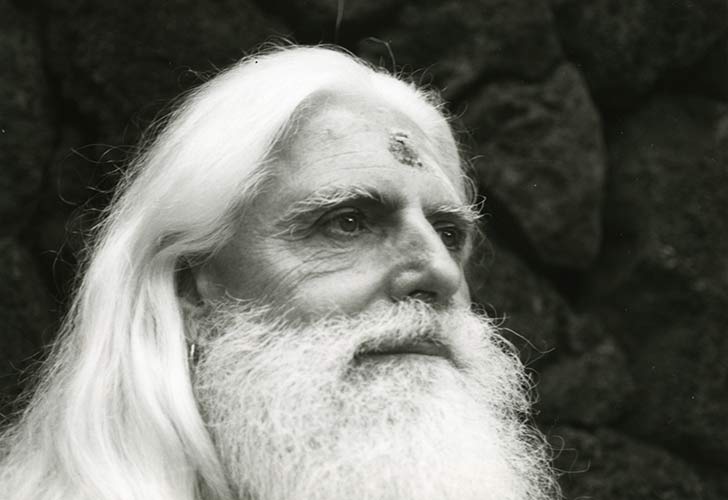
Please enjoy this rarely heard talk from Gurudeva in the 1970's about the "Wailua University of Contemplative Arts." This wonderful talk explores meditation and the practice of stabilizing the mind force. It expresses many of Gurudeva's early teachings which give a foundation for decades to come. Our thanks to Namrata Ragade for her loving seva of listening to countless archival audio files, which helped to bring this talk out of the archives and into the present. Aum Namah Sivaya.
Nature of the Satguru
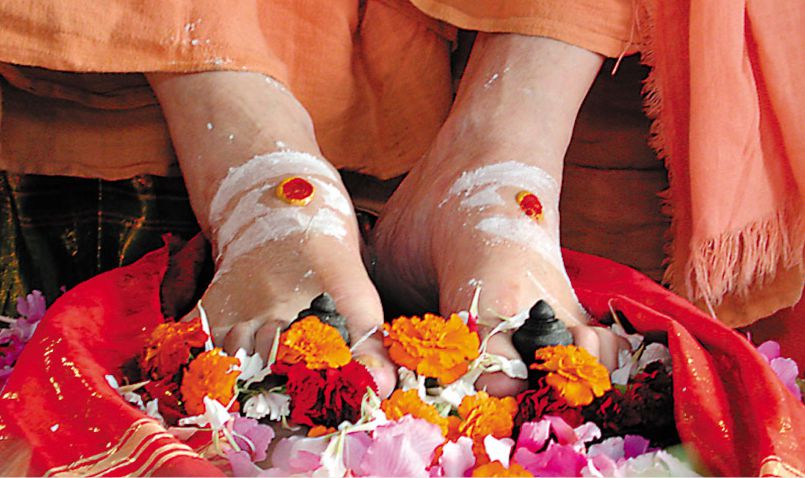
Today we open The Guru Chronicles and from the Introduction hear Gurudeva's upadesha on the nature of the guru and the worthy disciple:
India has always been the cradle of spirituality. During his 1895 lecture tour to India, Mark Twain wrote, "India is the cradle of the human race, the birthplace of human speech, the mother of history, the grandmother of legend, and the great grandmother of tradition. Our most valuable and most instructive materials in the history of man are treasured up in India only!"
What spared Hinduism the oblivion that claimed every other ancient faith? It cannot have been mere good fortune. India is a difficult land in itself, and its history is marked by the repeated absorption of whole races and religions from beyond its borders. In addition, it has had more than its share of foreign invaders, natural disasters and internal wars. Yet, drawing from some secret sustenance, Hinduism nourished with persistent vitality and retained its grip on the soul of India, never failing to inspire, never fading, ever renewed and strengthened from within. We can well ask who is responsible. Who kept the religion alive in the mind of man through all these millennia? Who keeps it vibrant and inwardly strong today? How many were they? Where do they live? How was it done? The answers lie, in part, in the pages of this book. Satguru Sivaya Subramuniyaswami, whose life story ends this biography, explained:
"Among a thousand devout Hindus, one or a few will abandon the world for a stricter path, living in seclusion by a river, in a cave in the hills or wandering, the sky his roof, God his landlord. Each Hindu looks up to the swami or sadhu, knowing they will one day be where he is now. Among a hundred thousand such tapasvins who search for God, one, or ten, will and That which all souls are seeking, so high is the summit, so steep the ascent. Realized saints and sages are rare, but never absent in India. Their absence would leave it a land like any other. Their presence makes it holy.
"Every Hindu generation has produced its farmers, lawyers, mothers, kings, beggars, scholars, priests, swamis and God-men. Yet all of these souls together do not carry or sustain the full force of the Sana-tana Dharma, for they cannot. They are each engaged in their own desires, their own affairs or their own quest. Their search continues. They do not yet possess the fullest knowledge; they have yet to accrue their soul's full maturity. Even after God Realization, the soul continues to evolve. It does not vanish, nor does the world disappear. An enlightened man can help many forward on the spiritual path, according to his maturity of soul. Whose mission is it to guide whole generations? Who turns from their search to guide hundreds of millions on their way? Only those whose search is utterly ended, only the perfected souls who have become the goal itself.
"Such men live; such men have always lived. They are known as siddhas, which means "accomplished ones" or "perfected ones." They are a special class of yogis, each a fully matured soul and heir to the inner force and subtle knowledge of the Sanatana Dharma even as the masses of India are heir to its outer precepts and practice. They hold the power of it and protect its destiny. One with Siva, they speak and behave only in expression of the will of God.
"All gurus differ one from another depending on their parampara, or lineage, as well as on their individual nature, awakening and attainments. Basically, the only thing that a guru can give you is your-self to yourself. That is all, and this is done in many ways. The guru would only be limited by his philosophy, which outlines the ultimate attainment, and by his own experience. He cannot take you where he himself has not been. It is the guru's job to inspire, to assist, to guide and sometimes even impel the disciple to move a little farther toward the Self of himself than he has been able to go by himself.
"The satguru is needed because the mind is cunning and the ego is a self-perpetuating mechanism. It is unable and unwilling to transcend itself by itself. Therefore, one needs the guidance of another who has gone through the same process, who has faithfully followed the path to its natural end and therefore can gently lead us to God within ourselves. Remember, the satguru will keep you on the path, but you have to walk the path yourself.
"It is the disciple's duty to understand the sometimes subtle guidance offered by the guru, to take the suggestions and make the best use of them in fulfilling the sadhanas given. Being with a satguru is an intensification on the path of enlightenment always challenging, for growth is a challenge to the instinctive mind. If a guru does not provide this intensification, we could consider him to be more a philosophical teacher. Not all gurus are satgurus. Not all gurus have realized God themselves. The idea is to change the patterns of life, not to perpetuate them. That would be the only reason one would want to and a satguru.
"Some teachers will teach ethics. Others will teach philosophy, language, worship and scriptures. Some will teach by example, by an inner guidance. Others will teach from books. Some will be silent, while others will lecture and have classes. Some will be orthodox, while others may not. The form of the teaching is not the most essential matter. What matters is that there be a true and fully realized satguru, that there be a true and fully dedicated disciple. Under such conditions, spiritual progress will be swift and certain, though not necessarily easy. Of course, in our tradition the siddhas have always taught of Siva and only Siva. They have taught the Saiva Dharma, which seeks to serve and know Siva in three ways: as Personal Lord and creator of all that exists; as existence, knowledge and bliss the love that flows through all form and finally as the timeless, formless, causeless Self of all."
From Darkness into Light
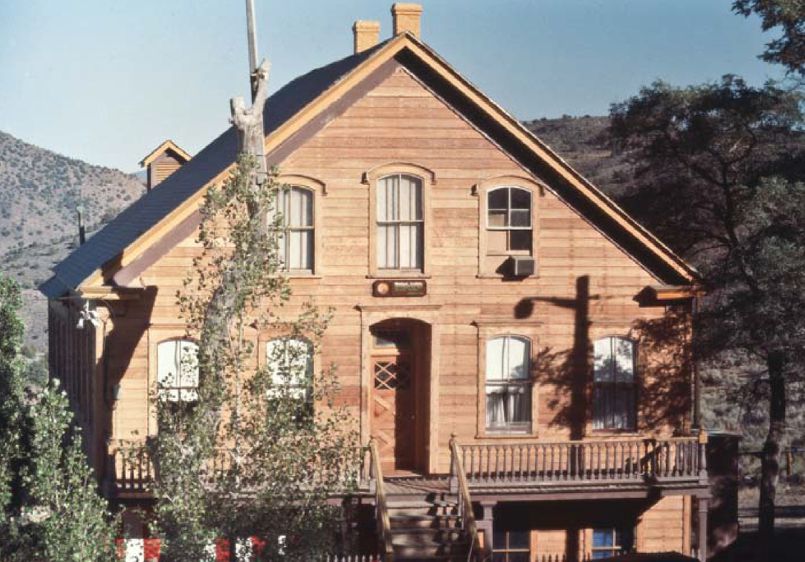
Mark Twain's Favorite Brewery
[This is a story from The Guru Chronicles]
Following a 1962 summer retreat at Angora Lake, Gurudeva visited nearby Virginia City, Nevada, to find a piece of property that could serve as a permanent retreat center. He didn't have to look far. About a quarter mile down the canyon from this legendary boom town of the Old West, he found a large, ramshackle brewery, originally built in 1864 on the site of the famed Comstock Lode Gold Rush. It was for sale.
Its austere Sierra Nevada mountain terrain, with its sagebrush and pion pine landscape, something that might intimidate others, was appealing to him. It was yogic, almost desolate. It was a place where the inner was more important than the outer. His first thought, when he stepped inside, was, "What a wonderful ashram this would make!'' He wandered through its cavernous rooms, on three floors, and, despite the dilapidated condition of the landmark, he arranged to purchase it.
The building, known as the Old Nevada Brewery, was the favorite haunt of American humorist Mark Twain. Samuel Clemens (Twain's real name) was first a writer and then the editor of the Territorial Enterprise in Virginia City from 1862 to 1864, a time during which he wrote his famed novel Roughing It. Each afternoon, it is said, he took refuge in the beer gardens of this biggest and most popular pub, telling tall tales to rowdy miners. And there were large crowds. In those days, Virginia City, with 30,000 people, was nearly half as populous as San Francisco, due to the gold rush which brought people from all over the world to the Wild West to dig into the sage-covered hills.
The landmark had been a silent memorial for half a century when Sivaya Subramuniyaswami, the new owner, stepped into its brick and fancy-woodwork rooms. Its age was showing. The resident caretaker was a grizzled old prospector who kept his mule in the basement and a pig in the shower. He was hard of hearing and required more than a little convincing that his residence had indeed changed owners.
The ashram became the Skandamalai Monastery (also called the Mountain Desert Monastery), reflecting Subramuniyaswami's insight that Murugan, Skanda, is the lord of renunciates, who would be its residents.
It would also be home of Comstock House, a major publication and printing facility, and the new center for the burgeoning Himalayan Academy courses and programs. For years, at this remote and desolate mountain aerie, 6,500 feet above sea level, the satguru would train his renunciates and issue forth the teachings of Vedanta, Siddhanta and the Saivite religion through literature, travel programs, seminars and courses.
There is a cave down Six-Mile Canyon Road, perhaps a mile beyond the monastery one of the hundreds of abandoned silver mines that honeycomb the region's hills, but horizontally deeper than most. One can walk for half a mile into its chambers. When Gurudeva discovered the cave one day, he was thrilled, and immediately set up a program for his monks. Most often alone, but sometimes in pairs, he sent them to meditate in the dark chambers. Taking only water, no food, the monk would enter the cave, walk through the long tunnel, dodging the massive wooden sup- ports that prevented cave-ins, until there was no light, then walk some more. Once inside the blackness of this space, he would settle down to stay for a day, for two days, as instructed, rarely more. He was to chant and meditate, nothing else except, and this was the sadhana, to seek the light within, the clear white light of the mind.
Sometimes, when meditating, one does not know if he is seeing the inner light or perhaps seeing the luminous space of the room beyond his closed eyes. But in a cave, deep in the Earth, there is no peripheral light. There is blackness. There is silence. There is nothing else. Monks would dive into themselves in that cave, distracted at first with the random intrusions of recent experience, of their projects back at the monastery, the paucity of food, whatever. But as the hours flowed by, the silence grew, and that silence worked well to bring them into the light of the mind.
And when you see light in a darkened cave, you know it's not coming from anywhere else; it is coming from you.
A few monks returned to speak of extraordinary moments when the light coming from within also illumined the floor and walls of the cave, brightly enough for them to discern details of the tunnel, bright enough for them to walk out without turning on their flashlight. Such was the way of the guru in those days. Gurudeva wrote about the inner light shortly after these cave experiences:
"Remember, when the seal is broken and clear white light has flooded the mind, there is no more a gap between the inner and the outer. Even uncomplimentary states of consciousness can be dissolved through meditation and seeking again the light. The aspirant can be aware that in having a newfound freedom internally and externally there will be a strong tendency for the mind to reconstruct for itself a new congested subconscious by reacting strongly to happenings during daily experiences. Even though one plays the game, having once seen it as a game, there is a tendency of the instinctive phases of nature to fall prey to the accumulative reactions caused by entering into the game.
"Therefore, an experience of inner light is not a solution; one or two bursts of clear white light are only a door-opener to transcendental possibilities. The young aspirant must become the experiencer, not the one who has experienced and basks in the memory patterns it caused. "
From the Archives – The Aftermath of Self Realization
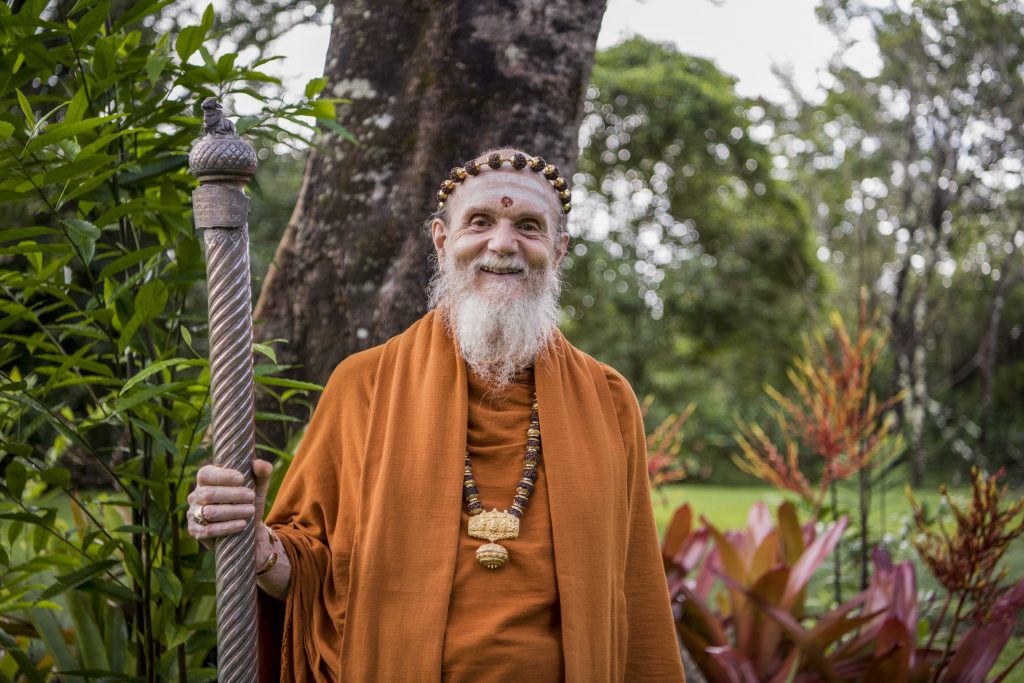
Go here for the full transcript: The Aftermath of Self Realization
Mauritius February Ganesha Homa
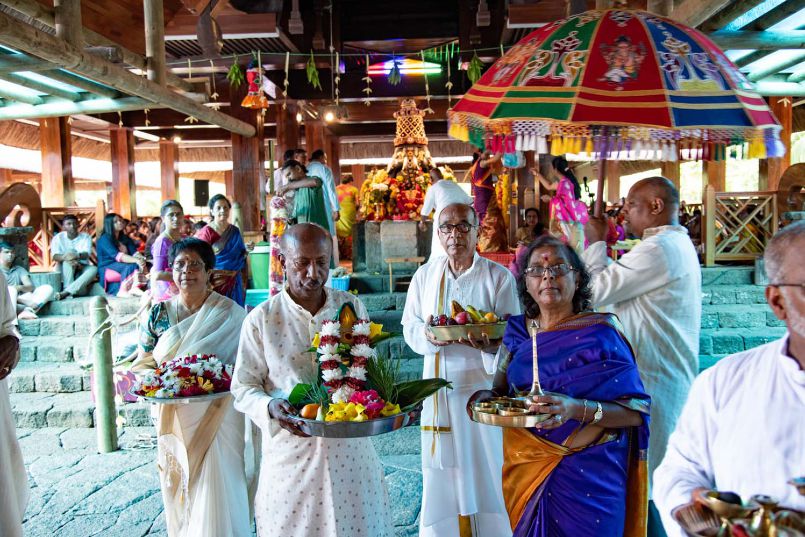
Click below for more photos of the February homa at our Spiritual Park, which also constituted the annual student prayers which had been delayed. Visit: www.saivasiddhanta.org
Find the Self
Satguru Sivaya Subramuniyaswami speaks on the mystical meaning of life and reminds us why we are here on Earth.
HAMSA: Our Newest In-Browser App
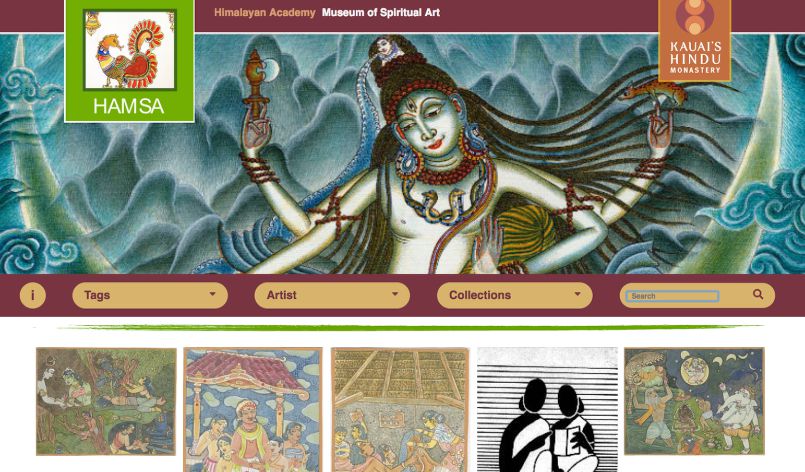
Welcome to HAMSA, or Himalayan Academy Museum of Spiritual Art. This in-browser application is our newest way to express and share all of Kauai Aadheenam's art with you.
Click the link below to check it out, or find the portal via our website's main menu: Look and Listen--> Art and Paintings.
Himalayanacademy.com/hamsa
From Our Gurus' Teachings
Archives are now available through 2001. Light colored days have no posts. 1998-2001 coming later.
